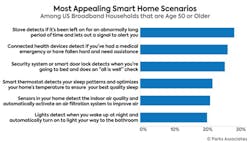The Smart Money: 5 Areas Where Home Security Can Be Extended
This article originally appeared in the October 2022 issue of Security Business magazine. When sharing, don’t forget to mention Security Business magazine on LinkedIn and @SecBusinessMag on Twitter.
The security industry uses the phrase “peace of mind” to highlight a primary emotional benefit of security services – without creating undue fear in the consumer. As the adoption of connected devices rises, manufacturers and integrators have a tremendous opportunity to capitalize on similar emotional benefits, leveraging various ways these product ecosystems can provide new and valuable experiences to consumers.
In turn, professional monitoring operators leverage their strengths by being always on and available to communicate with end-users to demonstrate the value they add beyond traditional monitoring solutions.
Here are five areas where peace of mind can be extended beyond the typical confines of a residential security solution:
Energy Management
Smart thermostats, along with additional smart energy devices like smart meters, smart light bulbs, and various distributed energy resources, provide high-value insights to consumers about their energy usage. These devices provide consumers with energy usage insights and can be integrated into a monitoring or automation service to create additional efficiencies and peace of mind for consumers and business owners.
For example, when a connected sensor indicates a window has been opened, a smart thermostat can trigger an energy-saving mode, then return to normal temperature control when the sensor indicates the window is closed again. Energy usage can be monitored and managed through smart schedules for energy devices, and consumers can see exactly how much energy their devices use and when they are used most.
Independent Living
The emergence of connected health products and monitoring services opens a new opportunity to serve consumers at home. The industry is undergoing a shift as seniors who have become accustomed to using new technologies expect to use them as part of their health routines in their homes.
Service providers, professional security monitoring, and PERS monitoring companies are exploring their potential role in consumer wellness, remote patient monitoring, and aging with independence. Providing solutions for aging consumers and their caregivers is a natural first step.
In the same way that security providers offer home monitoring services in case of intrusion, there is an opportunity to leverage this same technology to provide monitoring services for individuals in the home in case of medical-related emergencies.
Vehicle Monitoring
Car security is the next leading concern after protection of the physical home and safety of loved ones. Parks Associates research reveals that 69% of home security system owners are interested in vehicle monitoring as an add-on for home security systems, up from 39% in 2018.
The most desired capabilities are tracking a stolen vehicle and receiving alerts for possible break-ins. In addition, a major concern for households with children is teen safety, especially among new drivers.
Vehicle monitoring increases peace of mind for parents by monitoring the car itself with vehicle diagnostic alerts, as well as their children's driving behavior— alerting them in case of speeding, sudden acceleration, hard braking, or a collision. There is a valuable opportunity here for security providers to integrate vehicle monitoring services with the rest of their smart security offerings.
As residential security companies look to extend protection beyond the home, vehicle monitoring services provide a new opportunity to build upon their core capabilities and capture additional revenue.
Protecting Personal Property
Standard homeowner insurance policies provide limited coverage amounts for high-value personal property. Consumers note that the most important high-value personal property they want to monitor is electronics, followed by firearms, art collections (antiques and collectibles), and sporting equipment.
Products like rugged, battery-powered contact sensors that operate over LTE can offer protection for such items throughout the entire property, by securing outbuildings, sheds, and other structures that may not have Wi-Fi coverage or an electrical supply. Rising consumer interest in smart tracking devices can also create a new opportunity for residential security providers to serve consumers and build new revenue streams.
Extending the Perimeter of a Property
While consumers are most interested in preventing home intrusion, trespassing, or vehicle damage, protecting the outside of a home (as well as the yard, extended property, outbuildings, and equipment) is a natural extension of a security system; in fact, Parks Associates reports that 23% of home security system owners want to extend their system to protect their yard and outdoor items.
Outdoor security can also achieve what smart tags cannot: providing awareness and insight throughout the entire property and enabling consumers to take immediate action.
Outdoor cameras and video doorbells have generated significant consumer interest in addressing these exterior conditions. Security system-equipped households are the most likely to have networked cameras and smart video doorbells, the first step to deterrence. An additional step is the proactive use of smart outdoor cameras that deliver LED and audio warnings when their analytics detect unwanted activity. To further build on outdoor security protection, battery-powered LTE contact sensors integrate with the home security system – expanding awareness, insight, and action to access points and assets on the entire property.
Jennifer Kent is Vice President of Research for market research firm Parks Associates (www.parksassociates.com). For more information on the expansion of professional services beyond home security, download the firm’s recent whitepaper, Value Beyond Home Security: Expanding Product Ecosystems (in collaboration with Alarm.com) at www.parksassociates.com/whitepapers/beyondsecurity-wp2021.




